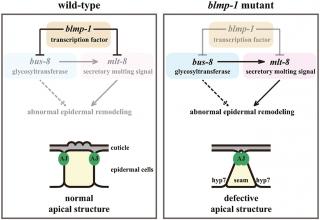Jun, 2022

Skin epidermis secretes apical extracellular matrix (aECM) as a protective barrier from the external environment. The aECM is highly dynamic and constantly undergoes remodeling during animal development. How aECM dynamics is temporally regulated during development, and whether and how its mis-regulation may impact epidermal cell morphology or function remains to be fully elucidated. Here, we report that the conserved Zn-finger transcription factor BLMP-1/Blimp1, which regulates epidermal development in C. elegans, controls apical cell shape of the epidermis by downregulation of aECM remodeling. Loss of blmp-1 causes upregulation of genes essential for molting, including bus-8 and mlt-8, in adult, leading to an abnormal shape in the apical region of adult epidermal cells. The apical epidermal morphological defect is suppressed by reduction of bus-8 or mlt-8. BUS-8 is a key mannosyltransferase, which functions in glycosylation of N-linked glycoproteins; MLT-8 has a ganglioside GM2 lipid-binding domain and is implicated in signaling during molting, a process where the old cuticle is shed and synthesized anew. Overexpression of bus-8 or mlt-8 induces an apical epidermal cell defect as observed in blmp-1 mutants. MLT-8::GFP fusion protein is localized to lysosomes and secreted to aECM. BUS-8 is important for MLT-8 stability and lysosomal targeting, which may be regulated by BUS-8-mediated glycosylation of MLT-8 and function as a molting signaling cue in aECM remodeling. We propose that BLMP-1 represses MLT-8 expression and glycosylation in the epidermis to prevent inappropriate aECM remodeling, which is essential for maintenance of apical epidermal cell morphology during larva-to-adult transition.